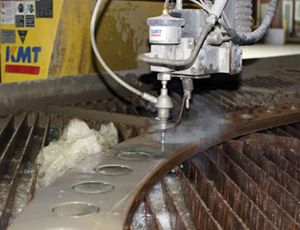
In composite cutting, a composite is a combination of different types of materials or metals. The main purpose of this is to increase the strength of the materials and the products they manufacture. It is for this reason, in addition to the fact that the materials are multifarious, that a different approach than the usual metal cutting methods is needed.
Typical methods like welding, plasma cutting, and laser cutting would jeopardize the equipment, as well as the workpieces. This is extremely dangerous as the materials are often used in the construction of items like aircrafts and medical equipment.
Welding, plasma cutting, and laser cutting all require heat to fuse and cut materials. Therefore, each method produces a heat affected zone, also known as HAZ. HAZ's risk the strength of materials as it alters their integral characteristics. While the HAZ may be minimal in some instances of these processes, waterjet cutting produces no HAZ.
Waterjet cutting is the process of using intensely flowing and compressed water to cut materials. In some cases, the water moves faster than 2,000 feet a second, and is compressed to about 90,000 pounds per square inch. At these rates, the water works to erode the material, as a means of cutting.
The two most conventional forms of waterjet cutters are called pure waterjets, and abrasive waterjets.
In pure waterjet cutters, plain, ordinary water is used as the cutting solution. In abrasive waterjet cutters, water is combined with granular substances to form an abrasive solution. Common abrasives used are garnet, and aluminum oxide.
Regardless of the type of waterjet cutting used, no waterjet cutter employs heat. This fact is just one of the many that make waterjet methods ideal for composite cutting.
In addition to no HAZ's, waterjets are the most appropriate approach to composite cutting as it causes no delamination.
Delamination is a main concern when considering composite cutting. It is the separation of layers and is often referred to as a mode of failure, or failure mechanisms. A separation of layers in composite cutting is a negative outcome as it reduces the strength of the materials and by default, the products the materials manufacture. Failure mechanisms are not an issue with waterjet cutters, whether it be pure waterjet machines or abrasive, as the water is not contact with the material for an extended period of time.
Other factors making waterjets ideal for composite cutting are:
-
The ability to produce smooth edges, with no burrs (rough edges)
-
Requires no secondary operations saving money and time
-
Produces minimal waste with cutting gaps measuring at a few tenths of a millimetre
-
Extremely efficient in relation to speed, making it able to meet high production rate demands
-
Capable of cutting hollow material composites, adding to its versatility with workable materials
While waterjet cutters have many advantages when considering precision cutting in general, it is the most fitting and effective method for composite cutting as well. It is able to work with many differing materials, while maintaining each materials integral properties as it does not require heat to operate. With no HAZ's produced, waterjet cutters are able to fulfill the purpose of composite cutting -- that is to increase the strength of the materials and therefore, the objects they help to manufacture.